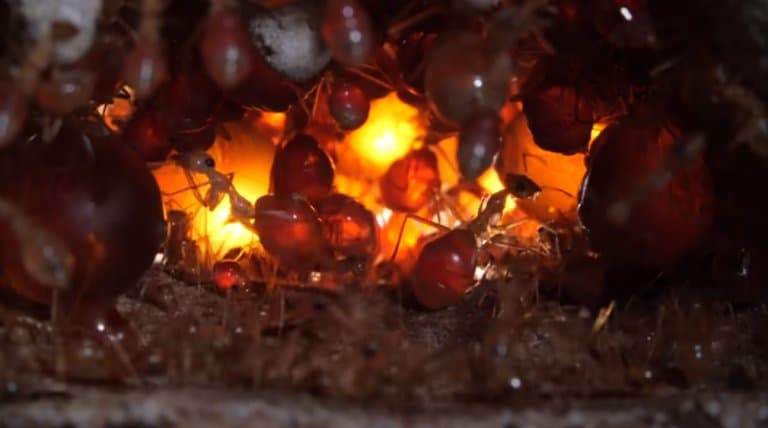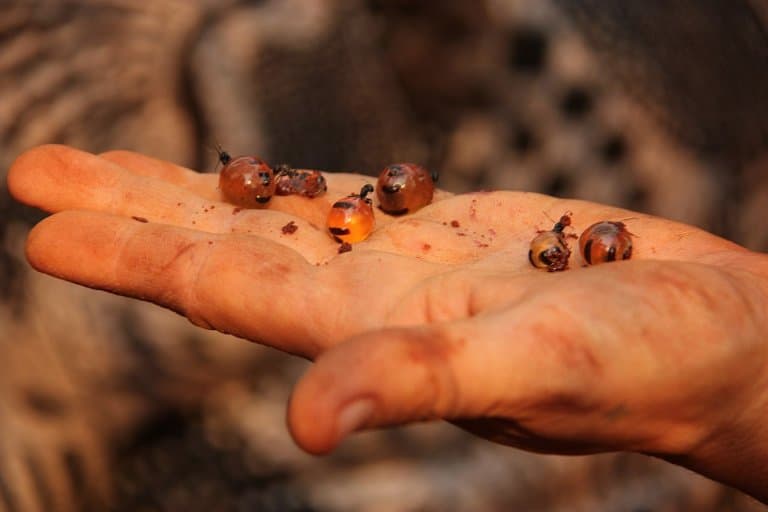Honeypot Ant Profile
Aside from a few purely predatory ant species (like army ants), most ants love sugar. Many ant species have a personal stomach and a social stomach (much like kids have a dinner stomach and a dessert stomach), and will collect some sugar for themselves and some to take back to feed the colony.
Having no thumbs makes it very difficult to carry any other way, but there are a few species that have developed an incredible adaptation that allows them to carry a huge amount of dissolved sugar back to the nest. These are honeypot ants.

Honeypot Ant Facts Overview
| Habitat: | Arid and semi-arid environments |
| Location: | Every continent except Antarctica |
| Lifespan: | Queens up to 8 years |
| Size: | Up to 1.5cm when full |
| Weight: | Up to 1.4g when full |
| Color: | Dark brown or black |
| Diet: | Mostly nectar, honeydew and insect protein |
| Predators: | Lizards, other ants, insectivores, small mammals, humans |
| Top Speed: | Unknown |
| No. of Species: |
Approx. 34, over about 7 genera |
| Conservation Status: |
Not Listed |
There are 34 species of honeypot ants that belong to 7 different genera.
They inhabit arid and semi arid landscapes in Australia, North and South Africa, North America and the southwestern Pacific islands, living in large underground colonies to escape the heat.
These amazing ants dedicate about 20% of their workforce to storing food. They feed on nectar, and since flowers in their habitat only bloom briefly after rain, it makes sense to store as much as you can to survive through the harder times.
They provide an array of nutritional meals for the rest of the colony, acting as suspended sauce bottles from inside the nest.
What workers can’t provide, they get from their own larvae, filling up an exceptional abdomen until it’s ready to pop. Most of them are quite tasty, too.
Interesting Honeypot Ant Facts
1. They are living larders
Many colony animal store food for harsher times. Bees are the best-known examples, with honeybees filling entire combs with kilograms of condensed nectar for the seasons of scarcity.
Thousands of species of ants also use their bodies to store food, but in the case of the honeypot ants, this is taken to the extreme.
An entire caste of ants is bred for the purpose. These are the ‘repletes’, and like the other castes in a colony, are reared specifically for their role. In honeypot ants, they are essentially a hybrid between a queen and a worker.
While foragers and workers may have an expandable abdomen or gaster, the repletes go even further – able to swell to the size of a small grape in some species.
Foragers will bring back liquid nectar in their abdomen and feed it to the repletes, who will hang from the walls of the colony and wait for harder times.

2. Repletes have well-developed ovaries
In general, insect colonies are formed by single (or sometimes a small number of) reproductive queens and a much larger force of sterile female workers. Males are reared only during the breeding season and are not otherwise present or useful.
This is an oversimplification, and there are plenty of occurrences of workers laying eggs, but the general theme is that well-developed ovaries are usually what makes the queen so fertile and so large.
So, the mystery of why repletes in honeypot ant colonies have well-developed ovaries is an interesting one. It might be that the reproductive hormones that give the queen her size also help the replete form such an impressive storage capacity.
This might explain why repletes are thought to live to much older ages than workers, just like the queen. However, this is not a genetic morphology – when repletes are removed from honeypot ant colonies, workers begin to morph into repletes to replace them, suggesting a hormonal switch might be responsible.
Regardless of how it comes about, the role of these swollen fatties is a simple one: they hang from the ceiling and supply food to the colony as needed. The method of supplying this food is an interesting one, though. 1 2
3. They share food, mouth to mouth
Trophallaxis is the name given to the sharing of food by individuals in an ant colony. It’s not exclusive to ants; bees, wasps, and birds also do this. Trophallaxis is different than sharing a plate of your chips with a friend, as it involves direct mouth-to-mouth – or even more delicious – mouth-to-anus fluid exchange.
It’s hypothesised that this form of feeding set the foundation for the evolution of colony animals.
Honey pot ants are one of the most extreme examples of this, able to not only store more resources inside their “social stomach” than other ants but even arrange a varied buffet for the colony.

4. There’s a menu
Honeypot ants don’t just supply one type of food to the colony. The ants themselves are arranged by food type. Colony members can pick and choose which replete to feed from, depending on what they’re looking for.
Darker bottles have more dissolved solids and are mostly sugar, while lighter bottles have more water. There are some anecdotal accounts of white, milky-looking substances inside honeypot ants, thought to be proteinous substances, too, which would make for a diverse selection of nutrients for the family larder!
Sometimes, there’s so much food, it won’t all fit. 3
5. They can burst
When a replete is stuffed to the brim, on occasion they may spring a leak. This can be a small leak or a catastrophic failure. In either case, when it happens, there’s a hurried rush to lap up all the good juices that escape, and not much of a concern for the poor replete, who may be fatally damaged.
So, it’s a bit of a dangerous job; though in ant colonies, there is a shared philosophy to put the colony first, and this means there’s little room for individuality.

6. The adults milk the young!
In a bizarre twist, it’s been recently discovered that in honeypot ant colonies, the babies feed milk to the adults.
While ants have been scrutinised since the early days of naturalism for their unusual and fascinating secrets, they’re still surprising researchers with their tricks.
When pupae were isolated from the colony for study, it was found they produced so much milk that it would eventually kill them. Being able to drown yourself in your own juices seems like a bit of a strange evolutionary choice, but it turns out this milk is designed for adult consumption.
When in the presence of adult ants, the milk is lapped up and consumed or stored, just like the sugary nectar, perhaps explaining the milky-looking honeypot ants described before, which are reported to taste like rancid fat. 4
7. They’re edible
These little blobs of sugar (or rancid fat) are found in various countries over the world, having evolved independently to store their food in similar ways.
As such, in multiple native cultures, they’ve become a bit of a delicacy, some are even dipped in chocolate before being eaten.
Just avoid the white ones!
Honeypot Ant Fact-File Summary
Scientific Classification
| Kingdom: | Animalia |
| Phylum: | Chordata |
| Class: | Insecta |
| Order: | Hymenoptera |
| Family: | Formicidae |
| Subfamily: | Formicinae |
| Genera: |
Camponotus of Australia Cataglyphis of North Africa Leptomyrmex of Melanesia Melophorus of Australia Myrmecocystus of North America Plagiolepis of South Africa Prenolepis of North America |
Fact Sources & References
- Olav Rueppell, Gro V. Amdam, Robert E. Page, Jr., and James R. Carey (2008), “From Genes to Societies“, National Library of Medicine.
- Adam Khalife, Christian Peeters (2020), “Food storage and morphological divergence between worker and soldier castes in a subterranean myrmicine ant, Carebara perpusilla“, Journal of Natural History.
- J. R. Conway (1977), “Analysis of Clear and Dark Amber Repletes of the Honey Ant, Myrmecocystus mexicanus hortideorum“, Annals of the Entomological Society of America.
- Tim Vernimmen (2022), “Ants make ‘milk’? This new discovery took scientists by surprise“, National Geographic.
